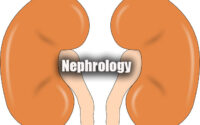Nephrology MCQ
Nephrology MCQ paper for the written examination is given below. Candidates who are looking for Nephrology exam MCQ paper can find in this section. The applied candidates who are getting prepared for the Nephrology can view this page for the Nephrology Last Ten Years MCQ Papers.

Download the Nephrology MCQ & Solutions & make it as a reference for your exam preparation. Take advantage of these Nephrology MCQ Papers in a proper manner to get qualifying Marks. Last 5 years Nephrology MCQ Papers provided here. Candidates who are applied for the above exam can check and download the Nephrology MCQ Papers from here.
MCQ on Nephrology
1. The following symptom often points to suspicion of renal tuberculosis :
(1) Recurrent painless hematuria
(2) “Acid sterile pyuria”
(3) Lack of constitutional symptoms
(4) All of the above
2. A 32-year-old woman presents to you after a recent hospital admission for flash pulmonary edema. She was diagnosed with hypertension several months ago. Her blood pressure remains poorly controlled despite compliance with a regimen of hydrochlorothiazide, amlodipine, and metoprolol. She denies having headache and palpitation. Her physical examination is remarkable for a blood pressure of 204/106 mm Hg in the left arm and bilateral abdominal bruits. You consider the diagnosis of renal artery stenosis (RAS) secondary to fibromuscular dysplasia (FMD). Which of the following statements regarding RAS and FMD is true ?
(1) Renal ultrasonography should be the first step in the evaluation of RAS because a finding of symmetrical kidneys precludes the need for further testing.
(2) Angioplasty with stenting can completely cures more then 50% of patients with hypertension and improves renal function in over one third.
(3) The segmental nature of medial fibroplasia, the most common subtype of FMD, results in the classic so-called beads-on-a-string appearance in the proximal third of the main renal artery.
(4) Surgical repair of aneurysms is required if their diameter is greater than 1.5 cm or if the patient has uncontrolled hypertension or is pregnant.
3. In patients with acute kidney disease, histologically renal ischaemia is most damaging to
(1) Glomerulus
(2) Proximal tubule
(3) Loopofhenle
(4) Distal tubule
4. The corticomedullary osmotic gradient is required for urine concentration. Which of the following would diminish this gradient ?
(1) Increased circulating vasopressin
(2) Increased blood flow through the renal medulla
(3) Activation of the sympathetic nervous system
(4) Activation of the renin angiotensin-aldosterone system.
5. Which is incorrect regarding CAPD peritonitis ?
(1) Gram stain will be positive in approx. 10-40% of culture positive bags.
(2) Staph aureus is the most common organism isolated.
(3) Antibiotics are not needed parentally usually.
(4) Cell count in bags must be > 100 leucocytes with > 50% neutrophils
6. Podocytes in the adult :
(1) are unable to replicate.
(2) are connected by gap junctions.
(3) have a positively charged glycocalyx.
(4) are connected to the GBM by hemidesmosomes.
7. You started a male patient with an A-V fistula op HD, and he wants you order buttonhole (constant site) cannulation. Which one of the following complications of buttonhole cannulation compared to the traditional rope-ladder technique or rotating cannulation sites is CORRECT ?
(1) Increases hematoma formation
(2) Increases infection rate
(3) Increases pain
(4) Increases needle sticks
8. All of the following are example of complicated urinary tract infection, except :
(1) UTI in males.
(2) UTI with in-dwelling catheter.
(3) Acute Pyelonephritis
(4) Recurrent cystitis in healthy females.
9. Ammonia is an affective important urinary buffer for which of the following reasons:
(1) Its production in the kidney decrease during chronic acidosis.
(2) The walls of the renal tubules are impermeable to NH3.
(3) The walls of the renal tubules are impermeable to NH4.
(4) Its acid base reaction has a low pKa.
10. An end stage renal disease patient comes to your office 4 weeks after radiocephalic AV fistula creation. Which one of the following measurements suggests that the fistula is functioning properly and will be ready in 3 months for cannulation ?
(1) Vein diameter 2 mm and access flow rate 300 mL/min
(2) Vein diameter 3 mm and- access flow rate 400 mL/min
(3) Vein diameter 4 mm and access flow rate 450 mL/min
(4) Vein diameter 6 mm and access flow rate 600 mL/min
11. A 32-year-old man was seen in the nephrology clinic with proteinuria. He has a background of TIDM and hypertension. He was treated with Lisinopril (10 mg), amlodipine (5 mg), aspirin (75 mg), simvastatin (40 mg), and insulin. On examination, he was overweight (BMI : 30 kg/m2), BP was 146/84 mmHg, and edema was present to midcalf level bilaterally. Investigations were as follows :
Serum creatinine: 1.6 mg/dl, Serum albumin: 2.8 g/dl, Urinary protein/creatinine ratio: 460 me/mmol. Which additional feature would provide justification for undertaking a renal biopsy ?
(1) Presence of diabetic retinopathy
(2) Duration of diabetes of 12 years
(3) Presence of nonselective proteinuria
(4) Negative dipstick urinalysis 4 months earlier
12. On ultrasound, compared to the liver, the normal adult renal cortex is
(1) Isoechoic
(2) Hyperechoic
(3) Hypoechoic
(4) Anechoic :
13. A 28-year-old man was found to have protein 2+ on a routine urinalysis during a life insurance medical. There had been a similar finding at his occupational health screen when he started at university. He had undergone further tests at the time and had been told there was nothing to worry about. Physical examination was normal and his BP was 118/76 mmHg. Urinalysis showed protein 2+. Investigations : serum urea 18 mg/dl, serum creatinine 0.8 mg/dl, estimated glomerular filtration rate (MDRD formula) 115 ml/min, urinary protein: creatinine ratio (clinic sample) 103 mg/mmol (<30), urinary protein: creatinine ratio (early morning) 14 mg/mmol (<30), How should the patient be advised ?
(1) Should have a renal biopsy to find out the cause of his proteinuria.
(2) Needs regular blood tests because he is at risk of worsening renal function.
(3) Reassured that he is at no increased risk of developing renal disease.
(4) Should be started on an ACE inhibitor.
14. A 39-year-old man with BMI of 32 refers to you with a history of headaches. Blood pressure during regular examinations has been approximately 186/98 mmHg. He is taking no medications and is a non smoker. His eGFR is 49 ml/min/1.73 m2 and he has 1.7g of proteinuria per 24 hours. His fundus examination was normal. No abnormalities were dentified on a renal ultrasound. What would you do next ?
(1) Refer for bariatric surgery immediately
(2) Control his BP and then a renal biopsy.
(3) Use an ACE-Inhibitor to optimize his BP
(4) Renal angiogram.
15. After the preceding patient undergoes kidney biopsy, the nurse calls your office to report gross hematuria that resolved spontaneously after two voids. The patient otherwise feels well. His vital signs are stable, and he is now voiding without difficulty. He has no flank pain. What is the next step ?
(1) Reassure the patient and obtain renal Ultrasonography
(2) Plan for renal angiography and gel- foam embolization of bleeding vessel.
(3) Admit for intravenous hydration
(4) Place a Foley catheter for 72 hours
16. Which of the following immunosuppressants is most commonly associated with proteinuria ?
(1) Azathioprine
(2) Sirolimus
(3) Cyclosporine
(4) Tacrolimus
17. A 65-year-old man underwent endoscopy to establish cause of hematemesis. The procedure was complicated by the development of an aspiration pneumonia and respiratory failure. A continuous infusion of intravenous lorazepam was required to control agitation and minimize peak Inspiratory pressures. Admission laboratory results (mmol/1) : Na+ 142, K+ 4.3, Cl- 105, HCO3- 22, creatinine 1.4 mg/dl, BUN 25 mg/dl, hematocrit 36, pH 7.35, pCO2, 45, pO2, 75. On hospital day 4, gastrointestinal bleeding recurred, and the patient was taken to the operating room and underwent oversewing of a bleeding duodenal ulcer. The patient remained hemodynamically stable throughout the hospitalization but continued to require IV lorazepam for sedation. Lab results (mmol/1): Na+ 138, K+ 4.8, Cl- 100, HCO3-, 10, creatinine 1.8 mg/dl, BUN 28 mg/dl, glucose 120 mg/dl, serum osmolality 330 mOsm/l (osmolar gap = 37).
What of the following is, the cause of this patient’s anion gap metabolic acidosis and increased osmolar gap ?
(1) Propylene glycol toxicity
(2) Diabetic ketoacidosis
(3) Lactic acidosis
(4) Uremic acidosis
18. Which of the following recipient factors is an absolute contraindication to transplantation ?
(1) Active sepsis
(2) HIV infection
(3) Age >70 years
(4) Previous malignancy
19. In hemodiaflltration, ultrapure dialysate and nonpyrogenic substitution fluid are generally used. Some of the complications observed in HD patients have been attributed to contaminants such as bacteria and endotoxins in dialysate. Which one of the following choices regarding ultrapure dialysate is FALSE ?
(1) Ultrapure dialysate is defined as the fluid that contains viable bacteria of < 0.1 colony forming units (CFU)/mL and endotoxin < 0.03 endotoxin units (EU)/mL.
(2) By definition, the standard dialysate contains < 100 CFU/mL and endotoxin < 0.25 EU/mL.
(3) Cuprophane and polyacrylonitrile dialysis membranes are more permeable to endotoxins and promote inflammatory cytokine production than polysulfone and polyamide dialysis membranes.
(4) There is substantial evidence that ultrapure dialysate is superior to standard dialysate in reducing the inflammatory cytokine production.
20. Why is hypomagnesemia associated with hypocalcemia ?
(1) Hypomagnesemia causes a shift of calcium into bone.
(2) Hypomagnesemia inhibits the secretion and action of parathyroid hormone.
(3) Hypomagnesemia causes renal calcium wasting.
(4) Hypomagnesemia impairs the peripheral actions of vitamin D.
| Practice Set | MCQs |
| Quiz | Questions and Answers |
21. All of the following agents mostly affect the B cells and antibody production, except :
(1) IVIG (intravenous immunoglobulin)
(2) Rituximab
(3) ATG (thymoglobulin)
(4) Bortezomib
22. A 22-year-old female student presented with hyperkalemia (5.9 meq/L) 6 weeks after starting a new oral contraceptive. Which one of the following oral contraceptives predisposes to hyperkalemia ?
(1) Ethinyl estradiol and Norethindrone
(2) Ethiny] estradiol and Norgestrel
(3) Ethinyl estradiol and Desogestrel
(4) Ethinyl estradiol and Drospirenone
23. CD-4+ regulatory T (Treg) cells generated in response to the persistent presence of alloantigen are thought to have an important role in transplant tolerance. Their tolerogenic actions are mediated through production of which of the following interleukin ?
(1) IL-2
(2) IL-5
(3) IL-6
(4) IL-10
24. Which of the following recommendations are not true regarding 2019 KDIGO consensus conference for nomenclature for kidney function and disease ?
1. All severe AKI cases requiring dialysis should be classified as AKI stage 3D.
2. All CKD patients requiring permanent dialysis should be classified as CKD GSD and term ESRD should be avoided.
3. Time duration criteria for rise in SCr of more than 0.3 mg/dl has expanded to 7 days since earlier criteria of 48 hours duration missed many cases of mild AKI.
4. A new term Acute kidney disease (AKD) was proposed to include all cases of AKI of <3 month duration, to differentiate them from incident CKD.
5. Diagnosis of AKI should mention both stage and cause rather than stage alone, eg. AKI stage 3 due to ATN.
(1) 3,5
(2) 1
(3) 3
(4) 4
25. Hemodiafiltration (HDF) combines both diffusion and convection. Which one of the following clinical benefits of HDF is FALSE ?
(1) HDF removes middle molecules more efficiently than high-efficiency and high-flux dialysis.
(2) Removal of inflammatory cytokines is better or higher with HDF than high-efficiency and high-flux dialysis.
(3) Preservation of residual renal function is much better with HDF than high-efficiency and high-flux dialysis.
(4) Improvement in albumin and other markers of nutrition is better with HDF than high-efficiency and high-flux dialysis.
26. Which is the most common genetic abnormality associated with atypical hemolytic uremic syndrome (aHUS) ?
(1) C3 mutations
(2) ADAMTS13 mutations
(3) CFH mutations
(4) CFTR mutations.
27. Which IgG subclass is predominantly deposited in cases with idiopathic membranous Nephropathy ?
(1) IgGl
(2) IgG2
(3) IgG3
(4) IgG4
28. A 42-year-old man is discovered to have proteinuria, impaired renal function (serum creatinine 2.3 mg/dl), and normocytic normochromic anemia (hemoglobin 8.2 g/dl). The physical examination shows hypertension (150/98 mmHg), mild obesity (BMI 31 kg/m2), bilateral corneal opacities, and 1+ edema. The albumin is 3.2 g/dl, total cholesterol 120 mg/dl, LDL cholesterol 80 mg/dl, HDL cholesterol 15 mg/dl, triglycerides 200 mg/dl. Serum C3 is normal. A fasting blood sugar is 120 mg/dl. Urinary total protein excretion is 4:6 g/day.
Which of the following is the most likely diagnosis ?
(1) Alport’s syndrome
(2) Adult-onset Cystinosis
(3) Lecithin-cholesterol acyltransferase deficiency
(4) C3 glomerulopathy
29. The key investigation for the diagnosis of immunotactoid glomerulopathy is
(1) Immunofixation or immunoelectrophoresis of serum proteins
(2) Characteristic light microscopy findings of MPGN pattern with nodular glomerulosclerosis in kidney biopsy sample
(3) Immunofluorescence examination of kidney biopsy sample
(4) Electron microscopy of kidney biopsy sample
30. What is the best predictor of successful induction of remission in a patient with ANCA disease ?
(1) ANCA titer
(2) Severity of proteinuria at initiation of induction therapy
(3) Percent of crescents seen in the renal biopsy specimen
(4) Serum creatinine at the start of induction therapy.
31. Which of following genetic mutation is not known to cause autosomal dominant form of familial FSGS ?
(1) INF2
(2) ACTN4
(3) TRPC6
(4) NPHS1
32. An elevated urinary CD80 antigen is a promising diagnostic bio-marker for which of the following glomerular diseases ?
(1) Minimal change disease
(2) Focal segmental glomerulosclerosis
(3) Membranous nephropathy
(4) Membranoproliferative glomerulonephritis
33. A 30 Years female developed kidney failure secondary to idiopathic FSGS. She is transplanted from live related donor. One week later patient started to have lower limb swelling. Urinary protein to creatinine ratio was 3.6 g/g. Kidney biopsy was performed and found recurrence of FSGS in allograft. What is best option of treatment in this case ?
(1) Pulse methyl prednisone
(2) Switch cyclosporine to Tacrolimus
(3) Intra-venous immunoglobulins
(4) Plasma exchange
34. If pathologic and serologic studies in a patient are diagnostic for anti-Glomerular Basement Membrane (GBM) disease, antineutrophil cytoplasmic antibody (ANCA) testing is:
(1) Unnecessary because it is unlikely to be positive.
(2) Necessary because it is positive in 25-33% patients and may change prognosis.
(3) Unnecessary because it would not change prognosis if positive.
(4) The disease is more like anti- GBM disease.
35. A 61-year-old man presented with complaints of weakness and loss of weight. His voice is hoarse. On examination he has pedal edema up to the tibial tuborosity, enlarged tongue and liver edge palpable up to three finger breadths below the right costal margin. Urinalysis showed 3+++ protein. What is the most appropriate test that will lead to the correct diagnosis ?
(1) 24-h urinary protein
(2) CECT scan abdomen
(3) Subcutaneous fat biopsy
(4) Urine protein electrophoresis
36. What is the most common underlying cause of hypercoagulable state in patients with Nephrotic syndrome ?
(1) Factor VIII deficiency
(2) Reduced concentration of Von Willebrand’s factor
(3) Reduced D-dimer levels
(4) Reduced antithrombin III activity
37. Which one of the following types of GN is most characteristically associated with cryoglobulinemia ?
(1) Rapidly progressive GN
(2) Mesangiocapillary GN
(3) Focal segmental glomerulosclerosis
(4) Diffuse proliferative GN
38. On December 23, 1954, Joseph Edward Murray created history by performing the world’s first successful renal transplant between the identical twins. He originally belonged to which medical streamline ?
(1) Urologist
(2) Plastic surgeon
(3) Nephrologist
(4) Immunobiologist
39. A 60-year-old woman complains of cramping during hemodialysis as well as weakness after each treatment. Post-treatment, pulse rate is 95/min and blood pressure is 90/60 mmHg. On physical examination, auscultation of the chest shows normal breath sounds. Examination of the extremities shows no edema. Which of the following is the most appropriate next step ?
(1) Add sodium modeling
(2) Continue monitoring blood pressure
(3) Decrease the dialysis time
(4) Increase the dry weight
40. Which of following antitubercular medicines require dose modification in patients with end stage renal disease ?
1. Rifampicin
2. Isoniazid
3. Ethambutol
4. Pyrazinamide
(1) 2,3
(2) 3,4
(3) 3
(4) 1,3
41. Which of the following symptom is specific to CKD, regardless of etiology ?
(1) Pain in renal angle
(2) Frequency
(3) Anuria
(4) Nocturia
42. The following are recognized presentations of autosomal recessive polycystic kidney disease, except :
(1) Nephrogenic diabetes insipidus
(2) Bilateral flank masses at birth
(3) Presentation with Nephrotic Syndrome
(4) Potter’s Syndrome
43. Which of the following statements is false ?
(1) The defined upper dose limit of epoetin is 60,000 IU/wk because it is known that cardiovascular toxicity occurs above this dose level.
(2) Dose requirements of epoetin are generally 20% to 30% less when the agent is administered subcutaneously compared with intravenously.
(3) Erythropoiesis-stimulating agent (ESA) therapy should be used with caution in patients with previous or current malignancy.
(4) Patients who are hyporesponsive to ESA therapy have a worse prognosis than those who do respond.
44. Which of the following combination is not correct ?
(1) Hexagonal shape : Cystine crystals
(2) Coffin lid appearance Magnesium ammonium phosphate
(3) Envelope shape : Calium oxalate monohydrate
(4) Shock of wheat appearance – Amoxycillin
45. A 40-year-old woman was referred because of refractory hypertension. She was being treated with telmisartan, amlodipine and prazosin. Her BP was 160/96 mmHg. Urinalysis showed protein 1+. Investigations: Serum Na 140 mmol/L, Serum K 3.3 mmol/L, Serum bicarbonate 28 mmol/L, Serum urea 16 mg/dl, Serum creatinine 1.2 mg/dl. Plasma renin activity was (after 30 min supine) 0.5 pmol/ml/h (1.1-2.7). What is the most likely diagnosis ?
(1) Chronic glomerulonephritis
(2) Pheochromocytoma
(3) Primary hyperaldosteronism
(4) Renal artery stenosis



